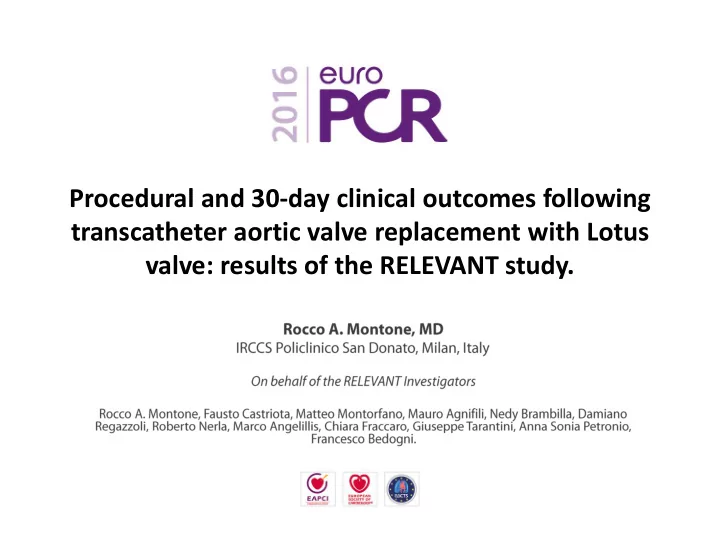

Procedural and 30-day clinical outcomes following transcatheter aortic valve replacement with Lotus valve: results of the RELEVANT study.
Potential conflicts of interest Speaker's name: Rocco Antonio Montone I do not have any potential conflict of interest
RELEVANT Study REgistry of Lotus valvE for the treatment of aortic VAlve steNosis with Tavr Italian prospective multicenter registry IRCCS San Raffaele Hospital University Hospital Padova GVM Cecilia Maria Hospital Cotignola IRCCS Policlinico San Donato University Hospital Pisa
Lotus aortic valve Characteristics • Second-generation TAVR device • Fully repositionable and retrievable • Adaptive seal designed to minimize paravalvular leak • Controlled mechanical expansion to obtain a precise positioning
RELEVANT Study Study design 208 patients enrolled Patients with severe aortic stenosis • From December 2013 to March 2016 • 30-day follow-up Primary endpoint: Local Heart Team High risk patients (mean STS score 8.5) All-cause mortality Secondary endpoints (VARC definition): TAVR with Lotus aortic valve • Stroke N = 208 patients • Vascular complication • Bleeding • New pacemaker implantation • Emergent cardiac surgery Discharge and 30-day outcome Site-reported events
RELEVANT Study Baseline characteristics n (%) or mean ± SD Variable 83.2 ± 6.4 Age, years Male 100 (48.1) Diabetes 56 (26.9) Chronic pulmonary disease 70 (33.6) Previous cerebrovascular disease 35 (16.8) Previous cardiac surgery 49 (23.6) Atrial fibrillation 51 (24.5) Pulmonary hypertension 73 (35.0) 7.1 ± 5.9 Euroscore II 17.8 ± 6.8 Logistic Euroscore 8.5 ± 5.3 STS score (mortality) Left ventricular ejection fraction >50% 132 (63.5) 30%-50% 55 (26.4) <30% 21 (10.1) Coronary artery disease 73 (35.0) Etiology of aortic valve disease Degenerative 196 (94.3) Bioprosthesis 4 (1.9) Bicuspid 8 (3.8)
RELEVANT Study Procedural details Variable n (%) General Anaesthesia 39 (18.8) Access route Trans-femoral 203 (97.6) Trans-subclavian 5 (2.4) Lotus valve size 23 mm 78 (37.5) 25 mm 82 (39.4) 27 mm 48 (23.1) Pre-implant balloon valvuloplasty 143 (68.8) Successful Lotus device deployment 208 (100.0) Access site closure Percutaneous 193 (92.8) Planned surgical 12 (5.8) Unplanned surgical 3 (1.4)
RELEVANT Study Clinical outcomes Endpoint Discharge, % 30-day, % Primary endpoint All-cause mortality * 2.4 2.9 Secondary endpoints Stroke 1.9 2.4 Major 0.5 1.0 Vascular complications 5.8 5.8 Major 2.0 2.0 Bleeding 10.1 11.5 Major or life-threatening 2.4 2.4 New pacemaker implantation 26.4 27.4 Emergent cardiac surgery 1.9 1.9 * In-hospital mortality: 5 patients (3 sepsis, 1 aortic rupture, 1 heart failure) 30-day mortality: 1 more patient (major stroke)
RELEVANT Study Echocardiographic outcomes Aortic gradient Aortic regurgitation 100% 5% 1% 1% 90% Mean aortic gradient (mmHg) 32% 24% 31% 80% 50 45.6 70% 40 60% 50% 51% 30 40% 20 68% 67% 11.3 11.6 30% 20% 10 10% 20% 0% Baseline Discharge 30-day Baseline Discharge 30-day none mild moderate severe
RELEVANT Study Comparison with other registries 30-day all stroke All-cause 30-day mortality 5.9% 4.2% 2.9% 3.9% 2.0% 2.4% RELEVANT RESPOND RELEVANT RESPOND REPRISE II REPRISE II (208 patients) (500 patients - interim) (208 patients) (500 patients - interim) (120 patients) (120 patients) 30-day new pacemaker implantation 30-day more-than-mild AR 36.5% 28.6% 27.4% 1.0% 1.0% 0.4% RESPOND REPRISE II RELEVANT RELEVANT RESPOND REPRISE II (500 patients - interim) (120 patients) (208 patients) (208 patients) (500 patients - interim) (120 patients)
RELEVANT Study Conclusions RELEVANT study is one of the largest real world TAVR registry of Lotus valve device. RELEVANT study demonstrates excellent procedural and 30-day clinical and echocardiographic outcomes, with low mortality and complications rates, confirming data of previously published Lotus valve studies.
Recommend
More recommend